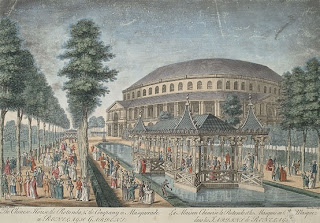Isabella reporting,
When thinking of the historical past, it's tempting to imagine the grander events as being, well, grand. The truth is that historical weather was every bit as unpredictable as its modern counterpart, and coronations, royal weddings, and balls were equally at the mercy of unwelcome rain and snow. This excerpt from the "Summer Amusements" in The Westminster Magazine, or The Pantheon of taste, June, 1777, describes a would-be glamorous event at Ranelagh, a fashionable pleasure-garden in 18th c. London. There's nothing worse than a big dance where no one feels like dancing, and not even the presence of dukes and duchesses could make up for drippy weather:
"About twelve, at which hour the company seemed most numerous, there might be six hundred in all, and to say the truth, a large part of the first fashion: the Duke of Cumberland, Duke and Duchess of Devonshire...and as many of the long list of noble Personages who generally frequent Ranelagh as were in town, being of the company. The Rotunda was most beautifully illuminated, and the orchestra filled with a fine, full band, who played various pieces of music...till past one in the morning. [But] Not a single dance was to be seen, unless the tedious perambulation of company round the room can be called dancing....Mr. Temple Luttrell, who planned the above entertainment, is said to have been a considerable loser by it, having only expended six hundred guineas for the use of the gardens and the expences of the concert.
The interior of the famous Ranelagh Rotunda is shown above. The crowd looks a little sparse here, too. The print, left, shows the Rotunda from the outside, its domed roof making it resemble a modern sports arena, and the gardens and canal the perfect spot for a stroll on a clear evening.
Above: The Interior of the Rotunda, Ranelagh Gardens, by Canaletto, c. 1751. Private collection.
Right: The Rotunda at Ranelagh, by Thomas Bowles, 1754.


 One of us --
One of us -- 



2 comments:
I love the notion of pleasure gardens and come back to the topic often. It must have been an absolutely delight for people who could afford the ticket price and had the appropriate clothes in 1777.
But what could they do about crappy weather? Close down for the evening? Move everyone inside the rotunda? Move the pleasure gardens to the channel islands? The owners of all the pleasure gardens, not just Ranelagh, must have torn their hair out every summer :(
I would love ot go to a party in a pleasure garden. It does sound a bit disappointing, but it also amuses me that it is considered a disaster when 300 people turned up! I imagine they would really despise my parties, I never have anywhere near 300!
Post a Comment